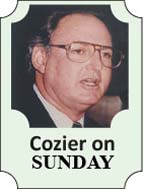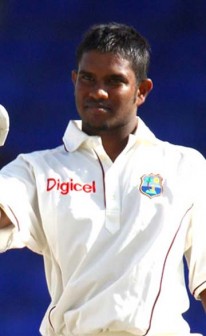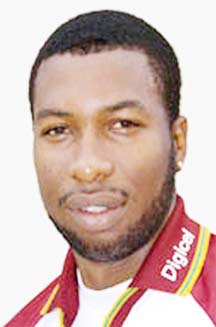They are three young tyros, all from Trinidad and Tobago but all with contrasting physiques, styles and places in the order, who immediately excited optimism that they would be the future of West Indies batting.
It is hope that, for various reasons, has gradually diminished.

Kieron Pollard has become one of the most destructive hitters in the lucrative Twenty20 game at the expense of the longer versions.
Darren Bravo has suddenly and inexplicably struggled to maintain the run-scoring form of last year that endorsed his status as something special.
Such reversals are disappointments to a West Indies team desperately in need of young batsmen of class.
Barath, a bubbly, diminutive right-hand opener with a mouthful of braces, was 16 when he compiled hundreds off the Leewards and the Windwards in his debut first-class season in the 2007 Carib Beer Cup.
It was talent confirmed with a sparkling 109 against Australia in Brisbane in November 2009 in his first Test appearance. At 19, he was the youngest century-maker for the West Indies, younger even than the great George Headley and Garry Sobers.

As Barath recorded his first two first-class hundreds in 2007, his teammate Pollard, a teenager three years his senior, was using an entirely different method to do the same.
Massively built, a foot taller than Barath at six feet, five inches and in at No.6 in the order, he used his immense power to hoist seven sixes in 126 off Barbados and pulverized the Leewards with six sixes in 117 off 87 balls. Here, quite clearly, was a rare phenomenon.
It was clout replicated in the ill-fated Stanford Twenty20 tournament and, more significantly, in the inaugural Champions League that made him an instant sensation in India and the most sought after player by the Indian Premier League (IPL).
Pollard’s initial IPL contract was US$750,000. Others followed – English county, Somerset, and South Australia in the Big Bash, Australia’s IPL equivalent.
After that, it was obvious where his future would be. In the three years since, he has been confined to one first-class match. He has maintained a place in the West Indies 50-50 team with little success but Test cricket is no longer realistically in the picture. He has become cricket’s first Twenty20 star.

The third member of the trio was Bravo, a slim left-hander extending the lineage of his established half-brother Dwayne and cousin Brian Lara whose elegant strokeplay and even facial resemblance bore out the family connection.
Bravo’s arrival was not as spectacular as those of Barath and Pollard. In fact he needed a few seasons to produce the performances required to settle his No. 3 position for Trinidad and Tobago. Once there, he gathered runs almost every time he batted.
He first won West Indies colours in the 2009 ODI home series against India. The following year he showed that he was, indeed, the real deal.
In five innings in the ODI ‘A’ team tri-series in Bangladesh along with the hosts and South Africa, he had a century (107 not out against South Africa), three half-centuries and an average of 103.
He helped himself to 102 in the first of two ‘A’ team Tests against Bangladesh before being summoned back to the Caribbean, (but not used) for the Tests against South Africa, Rejoining the ‘A’ team in England late for another tri-series involving the hosts and India, his scores were 83 and 62.
It was an accurate prelude to his next assignment, in Sri Lanka in November-December where he marked his Test debut with scores of 58, 80 and 68 in the manner of his illustrious left-hand cousin.
At 21, he was an exciting new addition to the up-and-comers of world, not just West Indies, cricket.
The script for 2011 has been quite different. He has been all but unrecognisable as the same player. His nimble footwork and flashing bat speed are no longer prominent. The self-confidence is correspondingly low.

In five home Tests against Pakistan and India, his return was an unsatisfactory 31.20 an innings. It was little better in the ODIs.
While he still averages 39.42 in his eight Tests and 31.56 in his 31 ODIs, he is yet to score an international hundred. It is a travesty for a batsman of such conspicuous quality.
He will continue to carry the expectations of the West Indies but, on the evidence of his fielding, there is need for him to concentrate harder on his all-round game.
Bravo’s “fielding is quite abysmal” was the way Cricinfo’s man in Bangladesh described it after the opening matches of the current tour. There is not a commentator who doesn’t refer to it on television.
He has dropped enough straightforward, and decisive, catches, at slip and the outfield, to upset even club captains, far less international coaches. When he held one in the recent ODI in Bangladesh, Cricinfo taunted him with the comment: “Top edged sweep, Darren Bravo takes the catch which is an event in itself.”
There is a host of examples to attest that fielding is one aspect of the game that any one can markedly improve on. As Ian Bishop suggested from Bangladesh last week, Bravo’s responsibility over the next year and a half or so is to aim for just that – excellence, as much with the bat as in the field.
At his best and once Barath overcomes the tendancy to injuries that, as of now, have so often laid him low – the West Indies could prosper over the coming decade.
This is a duty for the players themselves – in Barath’s case with the help of his trainers and physiotherapists.




